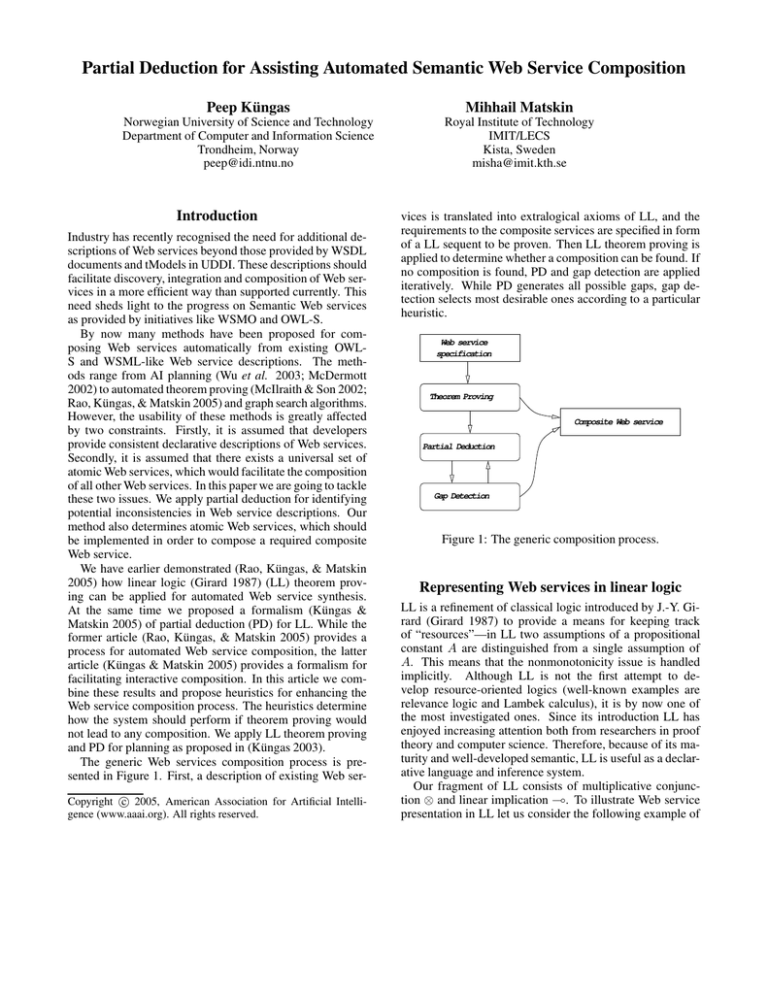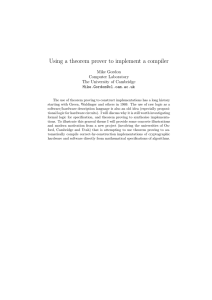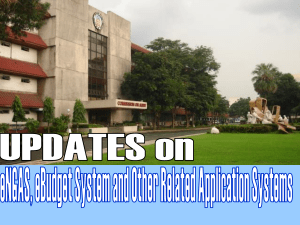
Partial Deduction for Assisting Automated Semantic Web Service Composition
Peep Küngas
Norwegian University of Science and Technology
Department of Computer and Information Science
Trondheim, Norway
peep@idi.ntnu.no
Introduction
Industry has recently recognised the need for additional descriptions of Web services beyond those provided by WSDL
documents and tModels in UDDI. These descriptions should
facilitate discovery, integration and composition of Web services in a more efficient way than supported currently. This
need sheds light to the progress on Semantic Web services
as provided by initiatives like WSMO and OWL-S.
By now many methods have been proposed for composing Web services automatically from existing OWLS and WSML-like Web service descriptions. The methods range from AI planning (Wu et al. 2003; McDermott
2002) to automated theorem proving (McIlraith & Son 2002;
Rao, Küngas, & Matskin 2005) and graph search algorithms.
However, the usability of these methods is greatly affected
by two constraints. Firstly, it is assumed that developers
provide consistent declarative descriptions of Web services.
Secondly, it is assumed that there exists a universal set of
atomic Web services, which would facilitate the composition
of all other Web services. In this paper we are going to tackle
these two issues. We apply partial deduction for identifying
potential inconsistencies in Web service descriptions. Our
method also determines atomic Web services, which should
be implemented in order to compose a required composite
Web service.
We have earlier demonstrated (Rao, Küngas, & Matskin
2005) how linear logic (Girard 1987) (LL) theorem proving can be applied for automated Web service synthesis.
At the same time we proposed a formalism (Küngas &
Matskin 2005) of partial deduction (PD) for LL. While the
former article (Rao, Küngas, & Matskin 2005) provides a
process for automated Web service composition, the latter
article (Küngas & Matskin 2005) provides a formalism for
facilitating interactive composition. In this article we combine these results and propose heuristics for enhancing the
Web service composition process. The heuristics determine
how the system should perform if theorem proving would
not lead to any composition. We apply LL theorem proving
and PD for planning as proposed in (Küngas 2003).
The generic Web services composition process is presented in Figure 1. First, a description of existing Web serc 2005, American Association for Artificial IntelliCopyright gence (www.aaai.org). All rights reserved.
Mihhail Matskin
Royal Institute of Technology
IMIT/LECS
Kista, Sweden
misha@imit.kth.se
vices is translated into extralogical axioms of LL, and the
requirements to the composite services are specified in form
of a LL sequent to be proven. Then LL theorem proving is
applied to determine whether a composition can be found. If
no composition is found, PD and gap detection are applied
iteratively. While PD generates all possible gaps, gap detection selects most desirable ones according to a particular
heuristic.
Web service
specification
Theorem Proving
Composite Web service
Partial Deduction
Gap Detection
Figure 1: The generic composition process.
Representing Web services in linear logic
LL is a refinement of classical logic introduced by J.-Y. Girard (Girard 1987) to provide a means for keeping track
of “resources”—in LL two assumptions of a propositional
constant A are distinguished from a single assumption of
A. This means that the nonmonotonicity issue is handled
implicitly. Although LL is not the first attempt to develop resource-oriented logics (well-known examples are
relevance logic and Lambek calculus), it is by now one of
the most investigated ones. Since its introduction LL has
enjoyed increasing attention both from researchers in proof
theory and computer science. Therefore, because of its maturity and well-developed semantic, LL is useful as a declarative language and inference system.
Our fragment of LL consists of multiplicative conjunction ⊗ and linear implication (. To illustrate Web service
presentation in LL let us consider the following example of
ski buying service adapted from (Rao, Küngas, & Matskin
2005). The available value-added services are specified as
follows:
` PRICE LIMIT ⊗ SKILL LEVEL (selectBrand BRAND
` HEIGHT CM ⊗ WEIGHT KG (selectModel LENGTH CM ⊗ MODEL
Γv =
` LENGTH CM (cm2inch LENGTH IN
` PRICE USD (USD2NOK PRICE NOK
The core service is specified as follows:
Γc = ` LENGTH IN ⊗ BRAND ⊗ MODEL ( PRICE USD
The constraints for the composite service are empty, since
we would like to keep the example simple:
∆=∅
Finally, the requirements for the composite service are
specified as follows:
{Γv , Γc }; ∆ ` HEIGHT CM ⊗ WEIGHT KG ⊗ PRICE LIMIT
⊗ SKILL LEVEL ( PRICE NOK
The required service can be proven to be correct (and then
extracted from the proof) from the specification of available
value-added services and the core service. The core service
and available value-added services are depicted respectively
in Figure 3 and Figure 2. The required service is graphically
presented in Figure 4. The structure of a solution for the
required service is represented in Figure 5.
PRICE_LIMIT
SKILL_LEVEL
selectBrand
BRAND
HEIGHT_CM
WEIGHT_KG
selectModel
MODEL
LENGTH_CM
LENGTH_CM
cm2inch
LENGTH_INCH
PRICE_USD
USD2NOK
PRICE_NOK
Figure 2: Available value-added services.
LENGTH_INCH
BRAND
MODEL
Partial deduction (PD) is known as one of optimisation techniques in logic programming. Given a logic program, partial
deduction derives a more specific program while preserving
the meaning of the original program. Since the program is
more specialised, it is usually more efficient than the original program, if executed. For instance, let A, B, C and
D be propositional variables and A ( B, B ( C and
C ( D computability statements in LL. Then possible partial deductions are A ( C, B ( D and A ( D. It is
easy to notice that the first corresponds to forward chaining
(from initial states to goals), the second to backward chaining (from goals to initial states) and the third could be either
forward or backward chaining.
Although the original motivation behind PD was to deduce specialised logic programs with respect to a given goal,
our motivation for PD is a bit different. We are applying PD
for determining subproblems, which cannot be solved, but
are possibly closer to a solution than an initial task. Similar approach has been applied in (Matskin & Komorowski
1997) for automatic software synthesis. One of the motivations there was debugging of declarative software specification. Here we apply similar technique for debugging and
analysing Web services’ declarative specifications.
In order to illustrate how to apply PD Web service
composition and gap detection, let us consider the abovementioned example. If we would discard unit conversion
services cm2inch and USD2NOK, there would be no solution available, which would satisfy user’s requirements. By
discarding these services we assume a situation where these
services have not been implemented yet or there are errors
in descriptions of these services.
At the same time, by applying PD we would be able to discover these missing Web services. Gaps in a partial solution
for a Web service composition task would identify new Web
services, which have to be implemented in order to complete the composite Web service. It may be possible also
that they represent Semantic Web service description parts,
which have to be modified. It could be possible that the developers, who wrote the semantic descriptions of particular
Web services, introduced some mistakes into descriptions.
Gap detection heuristics
We propose the following heuristics for gap detection:
selectSkis
PRICE_USD
Figure 3: The core service for buying skis.
HEIGHT_CM
WEIGHT_KG
SKILL_LEVEL
PRICE_LIMIT
Partial deduction
PRICE_NOK
Figure 4: The required service for buying skis.
1. Construction of all possible combinations of Web services. Any number of instances of a Web service may
exist in a solution. Between each two Web services, there
may be a gap.
2. Construction of all possible partial solutions through PD.
Each solution includes one gap the head and the tail of a
partial solution.
3. Select the longest partial solutions from the set of all possible partial solutions constructed through PD. Since a
longest partial solutions are most specific ones, they may
most precisely describe a desired solution. A developer
can always make it shorter or modify further.
PRICE_LIMIT
SKILL_LEVEL
HEIGHT_CM
WEIGHT_KG
selectBrand
BRAND
selectModel
MODEL
LENGTH_CM
selectSkis
cm2inch
PRICE_USD
USD2NOK
PRICE_NOK
LENGTH_INCH
Figure 5: The final service structure for buying skis.
4. Including core Web service(s) to partial solution gaps. A
developer can describe Web services, which must be included in solutions. If core services are not included in
a partial solution, we try to place them between the head
and the tail of the partial solution.
The preceding heuristics can be extended with the following techniques:
• Measure the lexical similarity between input/output
names. Since a developer might have made a mistake
while describing Web services, just unifying the names
might help.
• Use ontologies for deducing subtypes/supertypes and
generalise/specialise planning problems on-the-fly.
The preceding techniques would significantly help to debug declarative specifications of Web services and extend
the usability of the proposed strategies. Consider for instance a case where a user wants to compose a Web service,
which returns temperature at a particular location. However,
through PD we find a solution, which computes weather.
Fortunately, temperature would be a field in a computed
weather record. Thus after weather has been computed,
temperature would be extracted from it by applying knowledge in an ontology.
Conclusions
In this paper we applied partial deduction for identifying potential inconsistencies in Web service descriptions. The proposed methodology also determines which atomic Web services should be implemented in order to compose a required
composite Web service. These two issues, despite of being
important for practical systems, have not yet been considered in the literature of automated Web service composition.
We extended our RAPS planner (Küngas 2003) with PD
capabilities to support interactive problem solving and gap
detection heuristics. The planner applies LL theorem proving and PD for planning. As a result either complete or
partial solutions are constructed automatically. Partial solutions are processed further through the proposed gap detection heuristics.
We identified PD with core Web service inclusion as an
effective method for advising developers during automated
Web service composition. The method tries to extend partial solutions with core Web service descriptions. Through
this process additional gaps are identified, which should be
implemented and annotated by developers.
As a future work we would like to perform an analysis of
some industrial cases for identifying new methods for gap
detection and heuristics for filtering out potentially interesting partial solutions. Additionally we would like to incorporate ontologies and ontological reasoning to our tool. In-
corporation of ontologies to our tool would make it more
appealing for practical usage.
Acknowledgements
This work was partially supported by the Norwegian
Research Foundation in the framework of Information
and Communication Technology (IKT-2010) program—the
ADIS project.
References
Girard, J.-Y. 1987. Linear logic. Theoretical Computer
Science 50:1–102.
Küngas, P., and Matskin, M. 2005. Partial deduction for
linear logic—the symbolic negotiation perspective. In Proceedings of the Second International Workshop on Declarative Agent Languages and Technologies (in conjunction
with AAMAS 2004), DALT’2004, New York, USA, July 19,
2004, volume 3476 of Lecture Notes in Artificial Intelligence. Springer-Verlag.
Küngas, P. 2003. Linear logic for domain-independent
ai planning (extended abstract). In Proceedings of Doctoral Consortium at 13th International Conference on Automated Planning and Scheduling, ICAPS 2003, Trento,
Italy, June 9-13, 2003, 68–72.
Matskin, M., and Komorowski, J. 1997. Partial structural
synthesis of programs. Fundamenta Informaticae 30:23–
41.
McDermott, D. 2002. Estimated-regression planning for
interaction with Web services. In Proceedings of the 6th
International Conference on AI Planning and Scheduling,
Toulouse, France, April 23–27, 2002. AAAI Press.
McIlraith, S., and Son, T. C. 2002. Adapting Golog for
composition of Semantic Web services. In Proceedings of
the Eighth International Conference on Knowledge Representation and Reasoning (KR2002), Toulouse, France,
April 22–25, 2002, 482–493. Morgan Kaufmann.
Rao, J.; Küngas, P.; and Matskin, M. 2005. Composition of
semantic web services using linear logic theorem proving.
Information Systems. In press.
Wu, D.; Parsia, B.; Sirin, E.; Hendler, J.; and Nau, D.
2003. Automating DAML-S Web Services composition
using SHOP2. In Proceedings of the 2nd International
Semantic Web Conference, ISWC 2003, Sanibel Island,
Florida, USA, October 20–23, 2003.







